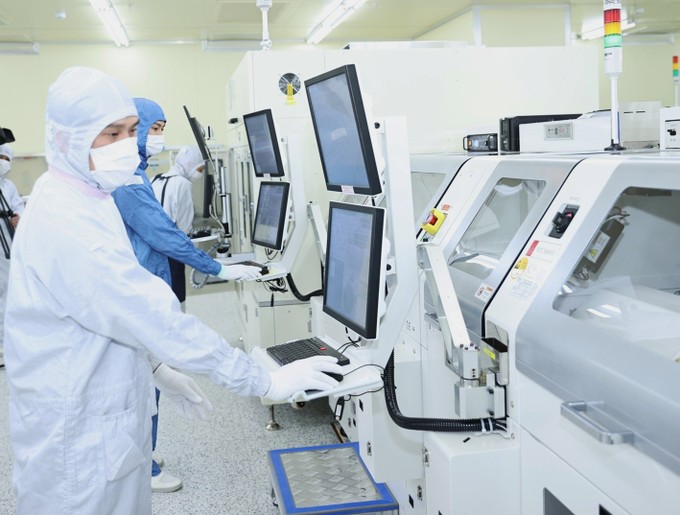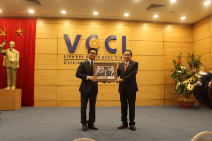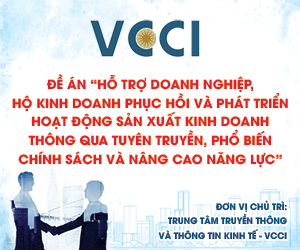Vietnam gears up for fourth wave of FDI
Vietnam has been attracting and utilizing foreign direct investment (FDI) for nearly four decades since 1988. This capital flow is regarded as one of the key pillars of economic growth.
Following three transformative waves of FDI that propelled remarkable milestones, Vietnam is now striving to usher in a fourth wave, focusing on emerging high-tech sectors.
Key milestones
Over nearly 40 years of foreign investment, the period from 1988 to 2000 marked the initial phase. In 1988, the first FDI license was issued in Ba Ria - Vung Tau. From 1991 onward, FDI inflows surged, heralding the first investment wave. Both the number of projects and registered capital repeatedly set new records. Between 1991 and 2000, total registered FDI reached $45.49 billion, with actual disbursement at $20.67 billion. During this time, Vietnam’s GDP grew at an average annual rate of 7.56 percent, with GDP in 2000 more than doubling that of 1990.
Between 2001 and 2010, total registered FDI amounted to $168.88 billion, while actual disbursement reached $58.48 billion—3.32 and 2.85 times higher than in the previous decade, respectively. The foreign investment sector played a crucial role in shifting Vietnam’s growth model from extensive to intensive development. Notably, 2006 saw the country’s first billion-dollar projects from US chipmaker Intel and South Korea’s Posco steel group, signaling the onset of the second FDI wave. In 2008, registered capital hit a record $72 billion. That year also marked the entry of Samsung, now Vietnam’s largest FDI investor, with its first factory in Bac Ninh.

Between 2011 and 2020, total registered FDI climbed to $270.69 billion, while actual disbursement reached $152.3 billion—1.6 times and 2.6 times higher than in the previous decade, respectively. By 2020, the FDI sector accounted for 20 percent of Vietnam’s GDP and around 55 percent of total industrial output, playing a pivotal role in the development of key industries such as oil and gas, electronics, chemicals, automobiles, motorcycles, information technology, telecommunications, steel, cement, food processing, leather, and textiles. However, the third FDI wave did not see the dramatic surges of 2005-2008 but instead experienced steady, sustained growth. The mergers and acquisitions (M&A) model began to take shape in 2014 and gradually became a new investment trend.
The Covid-19 pandemic in 2020 caused an unavoidable global economic downturn, yet Vietnam’s economy—and its FDI inflows—remained resilient. Between 2021 and 2023, total registered FDI reached $94.98 billion, with actual disbursement at $65.32 billion. In 2023, the FDI sector contributed 16.1 percent of total social investment. Major corporations such as Apple, Dell, Foxconn, Pegatron, and Nike relocated parts of their supply chains to Vietnam. Meanwhile, leading semiconductor and electronics firms—including Samsung, Synopsys, Qualcomm, Infineon, Amkor, and Nvidia—continued to expand their investment and partnerships. However, experts argue that the much-anticipated fourth investment wave has yet to fully materialize.
Expectations for emerging technologies
Over the past four decades, the FDI sector has played a crucial role in Vietnam’s socio-economic development and global economic integration. In 1995, domestic enterprises accounted for 73 percent of Vietnam’s export value, while foreign firms contributed just 27 percent. Today, this ratio has reversed, with FDI enterprises commanding over 70 percent of exports. Initially, foreign investment was largely concentrated in labor-intensive, low-value-added industries such as textile and footwear manufacturing. However, by the end of 2024, nearly 50 percent of cumulative FDI capital has been directed toward industrial processing and manufacturing.
Beyond these achievements, Resolution No.50-NQ/TW of the Politburo, which outlines Vietnam’s foreign investment strategy through 2030, sets even more ambitious targets. These include increasing investment from the US and expanding the presence of multinational corporations from Fortune’s Global 500 list operating in Vietnam by 50 percent.
Professor Nguyen Mai, Chairman of the Vietnam Association of Foreign-Invested Enterprises, emphasizes that achieving these goals—and successfully ushering in the fourth FDI wave—requires a fundamental institutional breakthrough. One such policy shift is embodied in Resolution No.57-NQ/TW, which focuses on the development of science, technology, and innovation. This resolution introduces preferential tax policies, financial support, and administrative reforms to streamline investment procedures and licensing, making Vietnam a more attractive destination for FDI, particularly in sectors such as semiconductors, digital technology, and artificial intelligence applications.
Additionally, by encouraging enterprises and research institutions to increase investment in research and development, the resolution aims to enhance manufacturing technology and accelerate the adoption of advanced technologies. It also promotes international collaboration in science and technology, connecting Vietnam with resources, technology, and global markets. The resolution calls for a comprehensive legal framework, a robust monitoring system, and periodic evaluations to ensure the effective allocation of capital in science and technology investments.
A single resolution alone is insufficient—there is still much to be done. Dr. Phan Huu Thang, former Director General of the Foreign Investment Agency (now under the Ministry of Finance), highlights the critical need for technology transfer and stronger linkages between FDI enterprises and domestic businesses. Without a well-developed supporting industry, robust high-tech workforce training, and deeper collaboration between Vietnam’s leading firms and foreign investors, even the most committed FDI enterprises may struggle to implement meaningful technology transfers.
Despite these challenges, recent market trends are promising. In the first two months of 2025, registered FDI in Vietnam exceeded $6.9 billion, while disbursed capital reached $2.95 billion—reflecting year-over-year increases of 35.5 percent and 5.4 percent, respectively. A recent report from Savills Vietnam, a UK-based real estate consultancy, underscores Vietnam’s rising prominence as a strategic hub for global technology corporations, thanks to its advantageous position within global supply chains.
This trend is evident in the growing presence of leading semiconductor firms such as Intel, Amkor, Nvidia, Infineon, Marvell, and Hana Micron. During a Lunar New Year 2025 meeting with Bac Ninh’s Party Secretary, Goertek—a company that has invested over $1.3 billion in four factories specializing in electronics and drone production—announced plans to double its annual drone output from 30,000 to 60,000 units.
Mr. Michael Kokalari, Chief Economist at VinaCapital, predicts a resurgence of FDI inflows into Vietnam’s stock market in 2025, in addition to continued strength in direct investment. He describes Vietnam’s 2024 FDI performance as highly positive and forecasts an increase of 7-10 percent in disbursed capital for 2025.
To sustain this momentum, VinaCapital advises Vietnam to focus on upgrading its manufacturing value chain and seizing opportunities in artificial intelligence (AI) and semiconductors. Strengthening the country’s higher education system—particularly in science, technology, engineering, and mathematics (STEM)—will be essential to unlocking Vietnam’s potential in high-tech industries. Additionally, streamlining administrative procedures remains a crucial step in fostering economic growth and attracting high-quality FDI.








